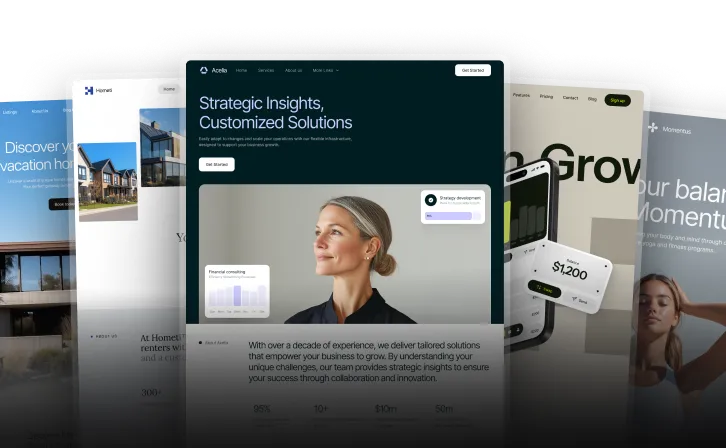Add Google Analytics to Webflow Templates
Unlock all templates




Key Steps to Get Started:
- Set Up Google Analytics: Create a GA4 property and get your Measurement ID.
- Integrate with Webflow: Paste the Measurement ID into Webflow’s integrations settings.
- Test the Connection: Use GA’s Real-Time reports to ensure data is flowing.
- Track Events: Monitor user actions like clicks, form submissions, or purchases.
- Analyze Data: Use reports to improve page performance, navigation, and conversions.
By connecting GA to Webflow, you’ll gain actionable insights to refine your website and boost results. Let’s dive into the details.
Set up Google Analytics to track data on your site

Before You Start
Before connecting Google Analytics (GA) to your Webflow template, make sure you have the necessary tools and understand the basics of analytics.
Set Up Google Analytics
Here’s what you’ll need:
- A Google account (Gmail or Google Workspace)
- Access to the Google Analytics 4 (GA4) platform
- A clear understanding of your website’s goals and key metrics
You can create your GA account at analytics.google.com. Google Analytics is free for most websites. Once that’s set up, ensure you have the right access to your Webflow project.
Check Webflow Access

Confirm that your Webflow account has the permissions to modify tracking codes and that your project is either live or ready to go.
| Access Level | What You Can Do |
|---|---|
| Site Owner | Full access to integrate analytics and edit tracking code |
| Admin | Can add or update tracking settings and view analytics data |
| Editor | Limited to viewing analytics data only |
| Designer | Can implement tracking code within site settings |
Once access is verified, get familiar with key analytics terminology.
Learn Basic Analytics Terms
Understanding these terms will help you make the most of your analytics setup:
| Term | Definition |
|---|---|
| Pageview | Recorded each time a user loads or reloads a page |
| Session | A collection of user interactions within a specific time frame |
| Bounce Rate | The percentage of sessions where only one page was viewed |
| Conversion | When a user completes a desired action (e.g., signing up or making a purchase) |
| Event | Specific user interactions, such as clicks or form submissions |
With these tools and concepts in hand, you’re ready to integrate, test, and refine GA in your Webflow template.
Adding Google Analytics to Webflow
Ready to integrate Google Analytics with your Webflow site? Let’s walk through the process step by step.
Create an Analytics Property
First, set up a GA4 property in your Google Analytics account:
- Go to the Admin section in Google Analytics.
- Under the Property column, click Create Property.
- Enter your website name and select your reporting time zone.
- Choose Web as your platform.
- Fill out the business information form.
- Copy your Measurement ID (it starts with "G-").
Keep this Measurement ID handy for the next steps.
Connect Google Analytics to Webflow
Now, let’s add your GA4 tracking code to Webflow:
1. Open your Webflow project and navigate to Site Settings > Integrations > Google Analytics.
2. Paste your GA4 Measurement ID into the designated field. Webflow will handle the integration code for you.
3. In your GA4 property settings, add your Webflow site’s domain as a data stream.
| Setting Type | Location | Action Required |
|---|---|---|
| Basic Integration | Site Settings > Integrations | Enter your Measurement ID |
| Enhanced Measurement | GA4 Data Stream Settings | Enable automatically collected events |
| Domain Configuration | GA4 Property Settings | Add your website domain |
Once this is done, you’re ready to verify that everything is working as it should.
Test the Connection
To confirm the integration is set up correctly:
- Publish your Webflow site with the updated settings.
- Open the Real-Time reports in your GA4 dashboard.
- Visit your website in a new browser tab.
- Check if your activity shows up in the Real-Time report.
If no data appears after 5 minutes, check the following:
- Ensure the Measurement ID is entered correctly.
- Verify that your site changes have been published.
- Disable any ad-blockers during testing.
- Confirm your browser’s privacy settings aren’t blocking analytics.
Once data starts flowing, you’ll be ready to analyze user behavior and optimize your site’s performance.
sbb-itb-fdf3c56
Extra Analytics Settings
Improving your Google Analytics (GA) setup can provide deeper insights and refine your conversion strategies. By adding advanced tracking, you can monitor detailed user interactions that matter most to your business.
Track Custom Events
In GA4, navigate to Configure > Events to set up custom events for specific user actions, such as:
- Button clicks
- Video plays and completions
- File downloads
- Form interactions
- Scroll depth
| Event Type | Custom Parameters Needed |
|---|---|
| Button Clicks | Yes – for tracking specific buttons |
| Form Submissions | Yes – for monitoring specific fields |
| Video Engagement | Yes – for tracking completion rates |
Once these events are created, configure GA4 Conversions to track these critical interactions effectively.
Set Up Goals
GA4 uses Conversions to track essential actions. To set this up:
- Go to Configure > Conversions.
- Click on "New Conversion Event."
- Choose from standard events or create your own.
Some key actions to track include:
- Newsletter signups
- Contact form submissions
- Product page views
- Download clicks
- Service inquiry completions
For e-commerce websites, you can take this a step further by incorporating store-specific metrics.
Add Store Tracking
- Enable E-commerce Settings Activate E-commerce tracking in GA4 under the E-commerce setup.
-
Configure Product Tracking
Set up tracking for the following actions:
- Product views
- Add-to-cart actions
- Checkout progress
- Purchase completions
- Revenue data
| Tracking Level | Metrics Monitored | Setup Complexity |
|---|---|---|
| Basic E-commerce | Orders, Revenue | Low |
| Enhanced E-commerce | Product Views, Cart Actions | Medium |
| Custom Events | Specific User Behaviors | High |
If you're using a Webflow template, make sure it includes the necessary data attributes for e-commerce tracking. Premium templates, like those offered by Temlis, often come pre-configured, making integration easier.
Using Analytics Data
Track User Actions
Dive into GA4 reports to fine-tune your Webflow site's performance. Pay attention to these key metrics:
- Page Performance: See which pages attract the most views and keep users engaged the longest. This highlights your strongest content.
- User Flow: Understand how visitors move through your site, including common paths and where they exit.
- Event Tracking: Keep tabs on important user actions, like clicks or form submissions, through your dashboard.
| Metric Type | Metrics | What It Tells You |
|---|---|---|
| Engagement | Time on page, scroll depth | Indicates how engaging content is |
| Navigation | Entry/exit pages, user flow | Measures how well your site structure works |
| Interaction | Click rates, form completions | Reflects conversion opportunities |
Use these insights to pinpoint where users drop off in your funnel and take action to improve.
Fix Conversion Issues
Look closely at your conversion funnel to spot and fix problems:
Drop-off Points
Find where users are leaving your funnel. Common culprits might include confusing navigation or slow-loading pages.
Mobile Performance
Check your mobile conversion rates. If they lag behind desktop rates, focus on:
- Mobile-friendly forms and clickable elements
- Faster load times and well-placed buttons
Choose Better Templates
Analytics can do more than highlight issues - they can help you select templates that improve performance.
Page Speed Impact
Compare how quickly different templates load. Faster templates often lead to:
- Fewer users bouncing off your site
- Longer engagement times
- Higher conversion rates
User Flow Optimization
Pick templates that align with your most effective user journeys. For instance, if users frequently convert after moving from blog posts to product pages, choose a template that emphasizes this pathway.
Temlis templates are designed to tackle common conversion challenges identified through analytics. They offer industry-tailored options such as:
- SaaS templates with pricing pages designed to convert
- E-commerce templates featuring smooth checkout experiences
- Wellness templates with easy-to-use booking systems
These templates are built with user behavior in mind, making it simpler to apply data-driven updates to your site.
Conclusion
Connect Google Analytics to your Webflow template to make smarter, data-driven decisions. This integration provides key insights into how your site performs and how users interact with it.
Why It Matters:
- Track user behavior in real-time to understand engagement.
- Optimize templates using real data for better results.
- Map out conversion pathways for improved clarity.
- Measure ROI effectively and identify areas for improvement.
These tools help you fine-tune your strategy continuously. Start with basic metrics, and as you grow more comfortable, explore custom tracking options to capture deeper insights.
Steps to Get Started:
- Ensure the tracking code is correctly implemented across all pages.
- Set up custom events to monitor important user actions.
- Define goals that align with your business objectives.
- Analyze mobile performance to address any usability issues.
By combining analytics insights with well-designed templates, you can make informed decisions that boost conversions. Whether you're managing an e-commerce store, a SaaS platform, or a portfolio site, let the data guide your choices.
For added design flexibility, check out premium templates from Temlis. Their customizable options can seamlessly complement your analytics-focused strategy, helping you maximize the impact of your Webflow site.
Related Blog Posts
Recommended posts
Unlock all templates







